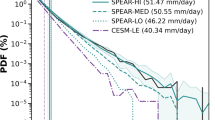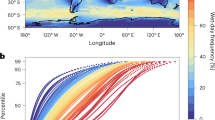Abstract
Extreme precipitation can cause flooding, result in substantial damages and have detrimental effects on ecosystems1,2. Climate adaptation must therefore account for the greatest precipitation amounts that may be expected over a certain time span3. The recurrence of extreme-to-heavy precipitation is notoriously hard to predict, yet cost–benefit estimates of mitigation and successful climate adaptation will need reliable information about percentiles for daily precipitation. Here we present a new and simple formula that relates wet-day mean precipitation to heavy precipitation, providing a method for predicting and downscaling daily precipitation statistics. We examined 32,857 daily rain-gauge records from around the world and the evaluation of the method demonstrated that wet-day precipitation percentiles can be predicted with high accuracy. Evaluations against independent data demonstrated high skill in both space and time, indicating a highly robust methodology.
This is a preview of subscription content, access via your institution
Access options
Subscribe to this journal
Receive 12 print issues and online access
$209.00 per year
only $17.42 per issue
Buy this article
- Purchase on Springer Link
- Instant access to full article PDF
Prices may be subject to local taxes which are calculated during checkout




Similar content being viewed by others
References
Min, S-K. et al. Human contribution to more-intense precipitation extremes. Nature 470, 378–381 (2011).
Pall, P. et al. Anthropogenic greenhouse gas contribution to flood risk in England and Wales in autumn 2000. Nature 470, 382–385 (2011).
Coles, S. G. An Introduction to Statistical Modeling of Extreme Values (Springer, 2001).
IPCC Climate Change 2007: Impacts, Adaptation and Vulnerability (eds Parry, M. L., Canziani, O. F., Palutikof, J. P., van der Linden, P. J. & Hanson, C. E.) (Cambridge Univ. Press, 2007).
Frich, P. et al. Observed coherent changes in climatic extremes during the second half of the twentieth century. Clim. Res. 19, 193–212 (2002).
Frei, C. et al. Future change of precipitation extremes in Europe: Intercomparison of scenarios from regional climate models. J. Geophys. Res. 111, D06105 (2006).
Wang, J. & Zhang, X. Downscaling and projection of winter extreme daily precipitation over North America. J. Clim. 21, 923–937 (2008).
Benestad, R. E. Novel methods for inferring future changes in extreme rainfall over northern Europe. Clim. Res. 34, 195–210 (2007).
O’Dowd, C. D. et al. The relative importance of non-sea-salt sulphate and sea-salt aerosol to the marine cloud condensation nuclei population: An improved multi-component aerosol–cloud droplet parametrization. Quart. J. R. Meteorol. Soc. 125, 1295–1313 (1999).
Orskaug, E. et al. Evaluation of a dynamic downscaling of precipitation over the Norwegian mainland. Tellus A 63, 746–756 (2011).
The BACC Author Team Assessment of Climate Change for the Baltic Sea Basin (Springer, 2008).
http://www.image.ucar.edu/nychka/manuscripts/nychka_extremesEPFL.pdf.
Benestad, R. E., Nychka, D. & Mearns, L. O. Specification of wet-day daily rainfall quantiles from the mean value. Tellus A 64, 14981 (2012).
Peterson, T., Daan, H. & Jones, P. Initial selection of a GCOS surface network. Bull. Am. Meteorol. Soc. 78, 2145–2152 (1997).
http://www.ncdc.noaa.gov/oa/climate/research/gdcn/gdcn.html.
Klein Tank, A. et al. Daily dataset of 20th-century surface air temperature and precipitation series for the European Climate Assessment. Int. J. Climatol. 22, 1441–1453 (2002).
Meehl, G. A. et al. in IPCC Climate Change 2007: The Physical Science Basis (eds Solomon, S. et al.) (Cambridge Univ. Press, 2007).
Benestad, R. E. Can we expect more extreme precipitation on the monthly time scale? J. Clim. 19, 630–637 (2006).
Blyth, A. M. et al. Observation of supercooled raindrops in New Mexico summertime clouds. J. Atmos. Sci. 54, 569–575 (1997).
Acknowledgements
The authors acknowledge a Norwegian Research Council grant (grant number 203866), the Norwegian Meteorological Institute and the National Center for Atmospheric Research.
Author information
Authors and Affiliations
Contributions
R.E.B. contributed to project planning, implemented the R-package, carried out the experimental work and the data analysis and took charge in the writing-up process; D.N. took part in project planning, interpretation of results and provided the statistical and gridding expertise; L.O.M. participated in the project planing and discussion of results.
Corresponding author
Ethics declarations
Competing interests
The authors declare no competing financial interests.
Supplementary information
Rights and permissions
About this article
Cite this article
Benestad, R., Nychka, D. & Mearns, L. Spatially and temporally consistent prediction of heavy precipitation from mean values. Nature Clim Change 2, 544–547 (2012). https://doi.org/10.1038/nclimate1497
Received:
Accepted:
Published:
Issue Date:
DOI: https://doi.org/10.1038/nclimate1497
This article is cited by
-
Positive correlation between wet-day frequency and intensity linked to universal precipitation drivers
Nature Geoscience (2023)
-
Effects of water supply on plant stoichiometry of C, N, P in Inner Mongolia grasslands
Plant and Soil (2023)
-
Interpolation of Precipitation Extremes on a Large Domain Toward IDF Curve Construction at Unmonitored Locations
Journal of Agricultural, Biological and Environmental Statistics (2022)
-
Assessment of spatiotemporal variability of precipitation using entropy indexes: a case study of Beijing, China
Stochastic Environmental Research and Risk Assessment (2022)
-
Enhanced propagation of rainfall kinetic energy in the UK
Theoretical and Applied Climatology (2017)



